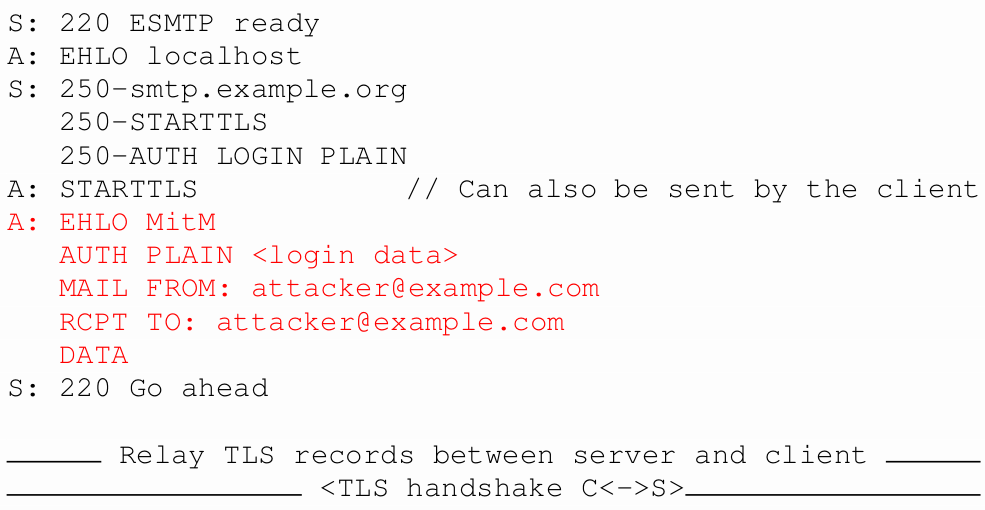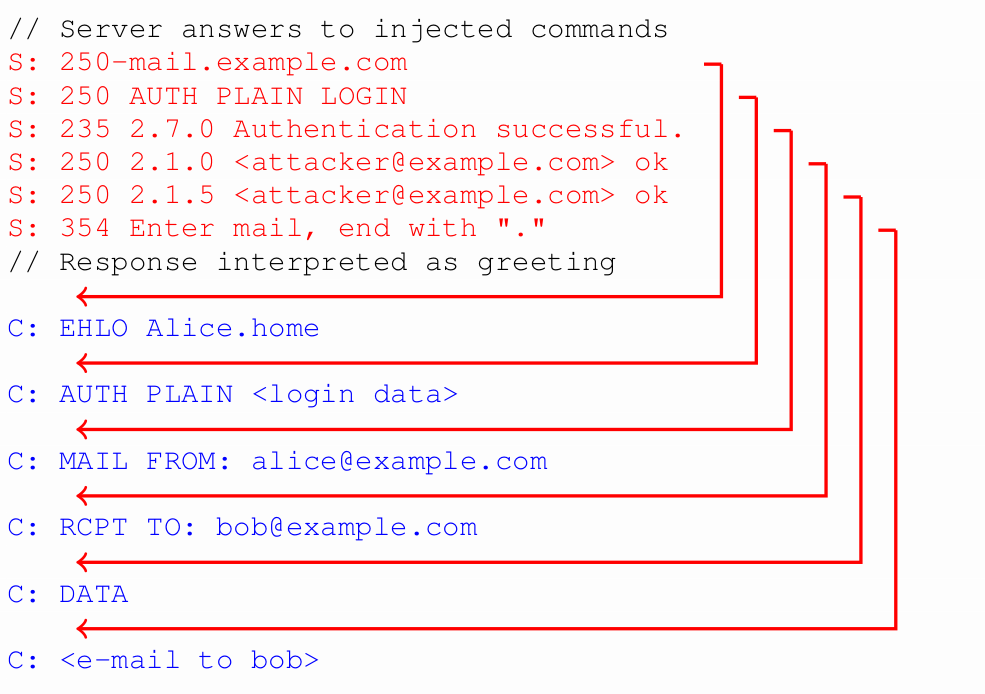NO STARTTLS
Hanno Böckhttps://nostarttls.secvuln.info/
E-Mail protocols
SMTP, POP3, IMAP
E-Mail connections from mail clients to servers come in three flavors:
- Unencrypted (Ports 25/587, 110, 143)
- Normal ("implicit") TLS (465, 995, 993)
- STARTTLS (upgrade of unencrypted connection)

STARTTLS
STARTTLS allows upgrading an insecure connection to a secure connection
STARTTLS was sometimes used as an opportunistic security mode
Opportunistic STARTTLS is trivially vulnerable to downgrade attacks, but usually modern clients don't do this
How does STARTTLS work?
S: 220 example.org ESMTP
C: EHLO myhost
S: 250-example.org Hello [93.184.216.34]
250-8BITMIME
250 STARTTLS
C: STARTTLS
S: 220 OK
[TLS Handshake]
C: EHLO myhost
S: 250-example.org Hello [93.184.216.34]
250-8BITMIME
250 AUTH PLAIN
C: AUTH PLAIN AGFsaWNlQGV4YW1wbGUuaW52YWxpZFM0NQ==
S: 235 Authentication succeeded
C: MAIL FROM:<alice@example.invalid>
[...]
STARTTLS Command Injection
A client (or an attacker) can send additional commands with the STARTTLS command and many servers will interpret these plaintext commands as if they were part of the encrypted connection
Originally found by Wietse Venema in 2011 in Postfix
Around 2% of mail servers were still vulnerable in our scans
How can this be attacked?


Attacker has login credentials of victim in his inbox
Response injection
We found that email clients are often vulnerable to a very similar bug, allowing the server (or attacker) to send further data together with the answer to the STARTTLS command
Many mail clients affected (including Apple Mail and Thunderbird)
PREAUTH
When connecting to an IMAP server, the server can send the PREAUTH keyword to indicate to the client that it does not need to authenticate
The IMAP standard says that STARTTLS can not be sent in authenticated state
Thus if a server manipulates the server answer and sends a PREAUTH keyword he can prevent the STARTTLS encryption
This was originally found in Trojitá in 2014, but as we learned it affected many more mail clients (including Apple Mail and Thunderbird)
Overall we found more than 40 STARTTLS-related vulnerabilities
Conclusion
If the same type of vulnerability show up again and again it should be considered a problem in the standard, not in the application
Do not use STARTTLS if you can avoid it, it's less secure and slower than implicit TLS
For E-Mail client-to-server connections this is easy and also recommended by existing standards (RFC 8314)
For E-Mail server-to-server STARTTLS is the only way to encrypt data, so these need careful auditing
STARTTLS is also used in other protocols, we have not looked at these, but we expect similar vulnerabilities there
Recommendations
Users
Configure your mail clients to use normal ("implicit") TLS, if your provider does not support this (Apple, Microsoft) then complain to your provider
Server administrators
Make sure you offer normal ("implicit") TLS to your users for all supported mail protocols
Consider deprecating plain text and STARTTLS ports altogether if you can
Mail software developers
Our research was published at the USENIX Security 2021 conference, we also published tools to test software for these vulnerabilities
Questions?
https://nostarttls.secvuln.info/